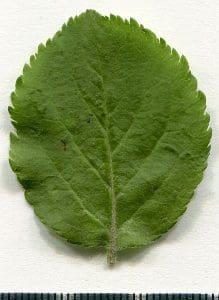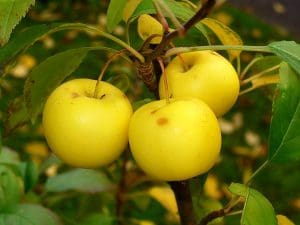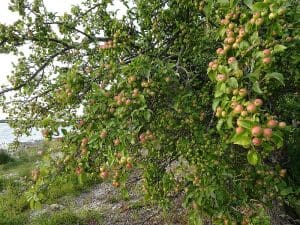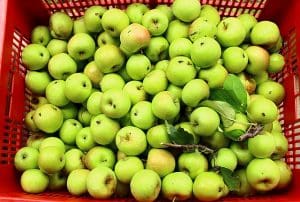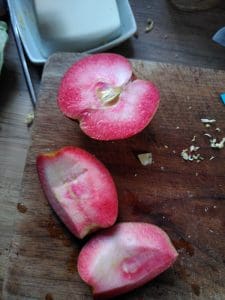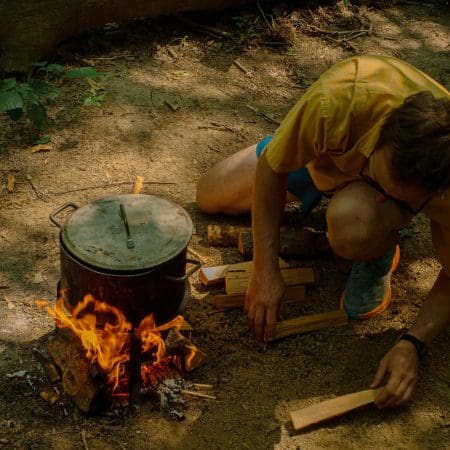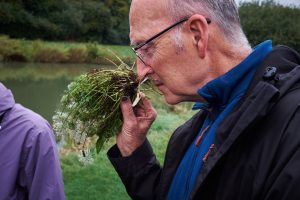Wild Apple / Summer / Autumn / Edible
The guide focuses on the Wild apple or Crab Apple (Malus sylvestris) but truly wild apples are getting harder to find. Most of the apples that you’ll see in the wild are technically ‘feral’. They have grown from a seed or core that has been discarded. Broadly speaking there are three types of apple found in the UK, Crab apples (Malus Sylvestris), which have been here since the last ice age, Domestic apples (Malus domestica) which is a hybrid of Malus Sylvestris and an Asian variety Malus sieversii. Then there are the ornamental apples that are sold in garden centers which are a hybrid of Asian and American species. Apples love to hybridize (worldwide there are over 7,500 varieties) and the wild species happily mix with domestic species meaning non hybrids are rare, sometimes the only way to know exactly which subspecies you have is DNA analysis which is beyond the realms of most of us.
Don’t feel the need to get too caught up with all of that though, if it looks like an apple it’s an apple. It’s as simple as that. That only toxins in apples and in the seeds, so the fruit of any apple that you find will be edible. Whether it’s a sweet delicious dessert apple that you can eat straight from the tree is really down to your taste.
Common Names
Wild apple, Crab Apple,
Botanical Name
Malus sylvestris
Scientific Classification
Kingdom – Plantae
Order – Rosales
Family – Rosaceae
Physical Characteristics of Wild Apple
Leaves
The leaves are a good indicator to look at, Malus sylvestris has shiny, hairless leaves. Domestic varieties have downy hairs all over the leaves and stems. Around 5-10 cm long, they are deep green in colour. Oval in shape with serrated margins.
Flowers
The flowers typically appear in spring, they have 5 petals and are white to pink in colour. The flowers grow on a spike called an inflorescence holding 4-6 flowers, the central flower of the inflorescence is called the “king bloom”, it opens first and can develop a larger fruit.
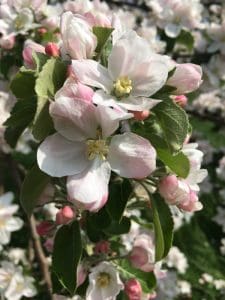
Fruit
The fruits are quite small up to 5 cm in diameter, they are green with a red tinge. They can be quite sour due to the high malic acid content.
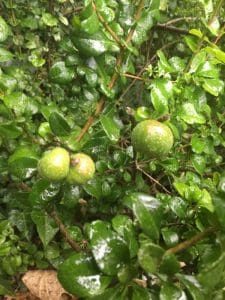
Stems
The stems have sharp thorns.
Habitat
It’s not an overly common plant anymore, as I said most apples you’ll find are feral but the Crab apple can be found in hedgerows, woodlands edges and field margins.
Known Hazards
The only toxins in apples are in the seeds, apple seeds and the seeds of many other plants, such as pears and cherries contain amygdalin, a cyanogenic glycoside composed of cyanide and sugar. When metabolized in the digestive system, this chemical degrades into highly poisonous hydrogen cyanide. A lethal dose of hydrogen cyanide can kill within minutes.
But before you get too worried the seeds need to be crushed or powdered (whole seeds will pass through your digestive tracts whole) and we are able to process small amounts of hydrogen cyanide, so chewing a couple of seeds would be harmless. Estimates vary but it seems that you would need to eat between 250 and several thousand before they do you any harm and if you think most apples will have between 6-10 seeds each, normal consumption is quite safe.
Some individuals do suffer from something called birch-apple syndrome and is found in people who are also allergic to birch pollen. Allergic reactions are triggered by a protein in apples that is similar to birch pollen. Reactions generally involve itching and inflammation of the mouth and throat, but in rare cases can also include life-threatening anaphylaxis. This reaction only occurs when raw fruit is consumed, as the allergen is neutralized in the cooking process.
Could be Confused with…
Other apples and they are all safe to eat.
Edible Uses of Wild Apple
The true wild apple can be a little sour and is best cooked and used to make jellies, jam and deserts.
The leaves can also be used fresh or dried to make herbal infusions.
Because of the high pectin content they are great for making fruit cheeses similar to membrillo.
Notes on Herbal Uses
The high pectin content in apples helps bulk up the stool to treat diarrhea and constipation. Apples also contain chemicals with anti-inflammatory and antibacterial effects. Apple peel contains a chemical called ursolic acid, which may play a role in building muscle and metabolism.
Extra notes from the Foragers
Apples are loved worldwide and around 80 millions tonnes are produced each year, with China accounting for around 40% of this.
References:
Learn how apples help decaffeinated coffee



